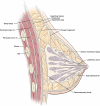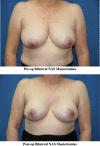Areola and nipple-areola-sparing mastectomy for breast cancer treatment and risk reduction: report of an initial experience in a community hospital setting
- PMID: 21308484
- PMCID: PMC3052454
- DOI: 10.1245/s10434-010-1365-9
Areola and nipple-areola-sparing mastectomy for breast cancer treatment and risk reduction: report of an initial experience in a community hospital setting
Abstract
Background: The use of areola-sparing (AS) or nipple-areola-sparing (NAS) mastectomy for the treatment or risk reduction of breast cancer has been the subject of increasing dialogue in the surgical literature over the past decade. We report the initial experience of a large community hospital with AS and NAS mastectomies for both breast cancer treatment and risk reduction.
Methods: A retrospective chart review was performed of patients undergoing either AS or NAS mastectomies from November 2004 through September 2009. Data collected included patient sex, age, family history, cancer type and stage, operative surgical details, complications, adjuvant therapies, and follow-up.
Results: Forty-three patients underwent 60 AS and NAS mastectomies. Forty-two patients were female and one was male. The average age was 48.7 years (range, 28-76 years). Forty mastectomies were for breast cancer treatment, and 20 were prophylactic mastectomies. The types of cancers treated were as follows: invasive ductal (n = 19), invasive lobular (n = 5), ductal carcinoma-in situ (n = 15), and malignant phyllodes (n = 1). Forty-seven mastectomies (78.3%) were performed by inframammary incisions. All patients underwent immediate reconstruction with either tissue expanders or permanent implants. There was a 5.0% incidence of full-thickness skin, areola, or nipple tissue loss. The average follow-up of the series was 18.5 months (range, 6-62 months). One patient developed Paget's disease of the areola 34 months after an AS mastectomy (recurrence rate, 2.3%). There were no other instances of local recurrence.
Conclusions: AS and NAS mastectomies can be safely performed in the community hospital setting with low complication rates and good short-term results.
Figures



References
MeSH terms
LinkOut - more resources
Full Text Sources
Medical
Research Materials
Miscellaneous

